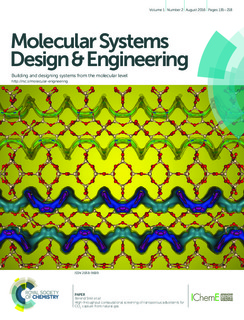| dc.contributor.author | Braun, Efrem | |
| dc.contributor.author | Zurhelle, Alexander | |
| dc.contributor.author | Thijssen, Wouter | |
| dc.contributor.author | Schnell, Sondre Kvalvåg | |
| dc.contributor.author | Lin, Li-Chiang | |
| dc.contributor.author | Kim, Jihan | |
| dc.contributor.author | Thompson, Joshua | |
| dc.contributor.author | Smit, Berend | |
| dc.date.accessioned | 2017-10-04T11:08:39Z | |
| dc.date.available | 2017-10-04T11:08:39Z | |
| dc.date.created | 2016-11-03T11:47:21Z | |
| dc.date.issued | 2016 | |
| dc.identifier.citation | Molecular Systems Design & Engineering. 2016, 1 175-188. | nb_NO |
| dc.identifier.issn | 2058-9689 | |
| dc.identifier.uri | http://hdl.handle.net/11250/2458336 | |
| dc.description.abstract | With the growth of natural gas as an energy source, upgrading CO2-contaminated supplies has become increasingly important. Here we develop a single metric that captures how well an adsorbent performs the separation of CH4 and CO2, and we then use this metric to computationally screen tens of thousands of all-silica zeolites. We show that the most important predictors of separation performance are the CO2 heat of adsorption (Qst,CO2) and the CO2 saturation loading capacity. We find that a higher-performing material results when the absolute value of the CH4 heat of adsorption (Qst,CH4) is decreased independently of Qst,CO2, but a correlation that exists between Qst,CH4 and Qst,CO2 in all-silica zeolites leads to incongruity between the objectives of optimizing Qst,CO2 and minimizing Qst,CH4, rendering Qst,CH4 nonpredictive of separation performance. We also conduct a large-scale analysis of ideal adsorbed solution theory (IAST) by comparing results obtained using directly-generated mixture isotherms to those obtained using IAST; IAST appears adequate for the purposes of establishing performance trends and structure–property relationships in a high-throughput manner, but it must be tested for validity when analyzing individual adsorbents in detail since it can produce significant errors for materials in which there is site segregation of the adsorbate species. | nb_NO |
| dc.language.iso | eng | nb_NO |
| dc.publisher | Royal Society of Chemistry | nb_NO |
| dc.rights | Navngivelse 4.0 Internasjonal | * |
| dc.rights.uri | http://creativecommons.org/licenses/by/4.0/deed.no | * |
| dc.title | High-throughput computational screening of nanoporous adsorbents for CO 2 capture from natural gas | nb_NO |
| dc.type | Journal article | nb_NO |
| dc.type | Peer reviewed | nb_NO |
| dc.description.version | publishedVersion | nb_NO |
| dc.source.pagenumber | 175-188 | nb_NO |
| dc.source.volume | 1 | nb_NO |
| dc.source.journal | Molecular Systems Design & Engineering | nb_NO |
| dc.identifier.doi | 10.1039/C6ME00043F | |
| dc.identifier.cristin | 1396964 | |
| dc.relation.project | Norges forskningsråd: 230534 | nb_NO |
| dc.description.localcode | © The Royal Society of Chemistry 2016. This article is licensed under a Creative Commons Attribution 3.0 Unported Licence. | nb_NO |
| cristin.unitcode | 194,66,35,0 | |
| cristin.unitname | Institutt for materialteknologi | |
| cristin.ispublished | true | |
| cristin.fulltext | original | |
| cristin.qualitycode | 0 | |

